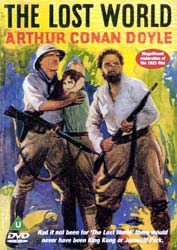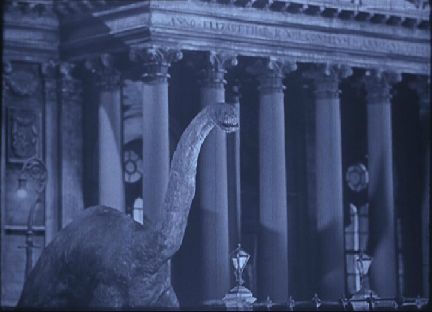Dom Robinson reviews
Eureka
- Cert:

- Cat.no: EKA 50003
- Running time: 92 minutes
- Year: 1925
- Pressing: 2001
- Region(s): 2, PAL
- Chapters: 19 plus extras
- Sound: Dolby Digital 2.0 (Stereo)
- Languages: English
- Subtitles: None
- Fullscreen: 4:3
- 16:9-Enhanced: No
- Macrovision: Yes
- Disc Format: DVD 9
- Price: £19.99
- Extras: Alternative music score, Audio Commentary, Biography on Sir Arthur Conan Doyle, Photo Gallery, Reproduction of the Original Souvenir Program
Directors:
- Harry O. Hoyt and Willis H. O’Brien

Video Producer:
- Serge Bromberg and David Shepard
Screenplay:
- Marion Fairfax
(based on the novel by Sir Arthur Conan Doyle)
Music:
- Robert Israel and The Alloy Orchestra
Cast:
- Paula White: Bessie Love
Sir John Roxton: Lewis Stone
Edward Malone: Lloyd Hughes
Professor George Challenger: Wallace Beery
Professor Summerlee: Arthur Hoyt
Gladys Hungerford: Alma Bennett
Marquette: Virginia Brown Fairei
Ape Man: Bull Montana
Zambo: Jules Cowles
Long before Spielberg diddled with dinosaurs in Jurassic Park, Sir Arthur Conan Doyle wrote The Lost World.
Backed up with stop-motion special effects that were state-of-the-art in their day, it is the story of Professor George Challenger (Wallace Beery) shouting his mouth off about the fact that the monsters do exist and he’ll prove it once and for all by taking Edward Malone (Lloyd Hughes) along to the Brazillian jungle and rescue the father of Paula White (Bessie Love). Of course, it’s a ridiculous expedition in that Challenger has no idea of what he’s letting himself in for.
I stated above that all the dialogue is in English, but that’s half-right as there is no dialogue. Inbetween the silent action, backed up by a musical score, everything stops occasionally to show a dialogue caption. Yes, it’s that old.
The following provides info about the restoration, courtesy of one of the video’s producers for this edition, David Shepard.
Restoring The Lost World.
“The Lost World was a worldwide sensation when it opened early in 1925. Just as Sir Arthur Conan Doyle incorporated the best palentological information of his time in the 1912 novel of living dinosaurs from the Jurassic age, so Willis H. O’Brien and his colleagues achieved stunning realism based upon information then available, brining the prehistoric creatures to life. Thanks to the dinosaurs, The Lost World remained one of the most admired and best-remembered films of the 1920’s, eclipsing even the astounding precedental model animation of Ladislas Starewicz.
By 1929, however, silent films were obsolete and the owners of The Lost World agreed to withdraw it from distribution in favour of a possible sound remake; all known prints and export negatives of alternative “takes” were destroyed. The remake appeared as the celebrated King Kong in 1933, while the forgotten domestic negative of the Lost World apparently decomposed and was discarded in the late 1940’s.
Fortunately, however, fragments of the silent film did remain: for a few years beginning in 1929, Eastman Kodak released a 16mm home movie abridgment slightly less than an hour in length through its Kodascope libraries while its educational department, Eastman Teaching Films, offered fifteen minute of excerpts edited as an instructional film on prehistoric life. Collectors preserved the original trailer and a demonstration reel of the dinosaurs shown in 1925 to the society of Motion Picture Engineers. All of these would still have would still have added little to the home movie version but, miraculously, a worn but photographically beautiful version but 35mm print of the Czech version was preserved in Prague. Although it, too, is only about an hour long, it contains a selection of scenes different from the American abridgement, and it was immediately clear that combining these elements would result in a much longer film which, although still missing bits and pieces, contains all of the most important scenes and a substantially complete story.
The first reconstruction of the Lost World was undertaken by the George Eastman house, an international museum of photography in Rochester New York.
The present version was made independently of Eastman House and following somewhat different principles of reconstruction. Eight original source prints were provided from various private collections and through the kindness of the film archive of the Czech Republic. All elements were digitally mastered to video using the most sophisticated current techniques to clean the images and minimize scratches and other abrasions. On an American AVID non-linear digital editing system, editor Mathieu Duboscq compared the available versions of every shot and rebuilt the film using flexible criteria such as shot length and condition, photographic quality, and content (which sometimes varied between the domestic and export versions).
Mathieu, co-producer Serge Bromberg and I then shaped and tilted up the final film, guided by the 1929 American abridgement with its original titles, the 1925 printed music score and timings, Sir Arthur Conan Doyle’s wonderful novel, and the 1924 production script (which however, varied substantially from the film as photographed and released). Our final selection of shots was then given further digital repair to eliminate splice lines, punch marks and other conspicuous defects. All titles were made in facsimile of the original typography, speed adjustments were made to some of the shots, and the entire film was carefully tinted in the style of the period. Our desire was to make a smooth and entertaining film, as true as possible to the vanished original, but free of obvious remainders that the project had been patched together from fragments. Our final thoughts echoed Doyle’s own when he wrote that “in humble and thankful mood, I close this account. Our eyes have seen great wonders, and each in his own way is a better and deeper man”. And The Lost World is back to thrill a new generation.”
 The Tory leadership contest gets a new contender.
The Tory leadership contest gets a new contender. It won’t surprise anyone to learn that the film is presented in its original fullscreen ratio. I’ve only given the picture quality half marks because compared to how a film could look when made today it does fall short, but to criticise it like that would be to miss the point of the restoration. Rest assured that it looks exactly as you’d expect it to. The average bitrate is 6.13Mb/s, briefly peaking over 8Mb/s.
There are two audio soundtracks in stereo on here. One being the traditional music accompaniment by Robert Israel and the alternative being by The Alloy Orchestra.
The extras contain a 12-minute piece of scrolling text that provides info about the film as well as, in part, a Biography on Sir Arthur Conan Doyle. Another 12-minute extra is a series of animation outtakes which are rather a work-in-progress. A feature-length Audio Commentary is provided by Roy Pilot, author of “The Annotated Lost World”.
A Photo Gallery of the “dino-stars” with 12 pictures, culminating in an extra one of the Original Souvenir Programme.
The disc contains 19 chapters, but no subtitles. The menus are subtly animated with part of the score in the background.
PICTURE QUALITY
SOUND QUALITY
EXTRAS











 OVERALL
OVERALL 


Reviewer of movies, videogames and music since 1994. Aortic valve operation survivor from the same year. Running DVDfever.co.uk since 2000. Nobel Peace Prize winner 2021.
